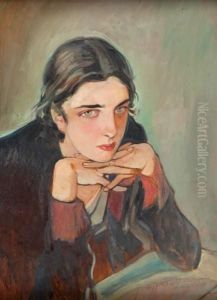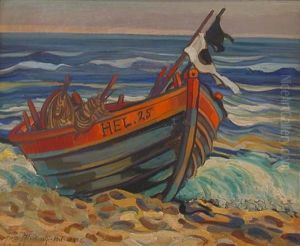Janusz Kotarbinski Paintings
Janusz Kotarbiński was a Polish painter and illustrator, known for his historical and mythological scenes. Born on October 7, 1848, in Radom, Poland, which was then a part of the Russian Empire, Kotarbiński developed an interest in art at an early age. He pursued his education at the School of Fine Arts in Warsaw, where he studied under the tutelage of such notable figures as Rafał Hadziewicz and Wojciech Gerson, prominent artists of the time.
After completing his studies in Warsaw, Kotarbiński continued his art education abroad. He moved to Munich, which was a major artistic hub in the 19th century, and further honed his skills at the Munich Academy of Fine Arts. His time in Munich allowed him to absorb the techniques and styles that would later influence his historical paintings.
Kotarbiński's work is often characterized by a romantic fascination with the past, which was a common theme among artists and intellectuals in Poland during the period of partitions, when the country was divided between Russia, Prussia, and Austria. He created numerous paintings that depicted scenes from Polish history, literature, and mythology. His style was heavily influenced by the Academic art movement, and he was known for his meticulous attention to detail and his ability to convey mood and atmosphere.
Throughout his life, Kotarbiński exhibited his work in various prestigious venues, including the Society for the Encouragement of Fine Arts in Warsaw and the Kraków Society of Friends of Fine Arts. In addition to his historical paintings, Kotarbiński also worked as an illustrator, contributing to periodicals and books, which helped disseminate his vision of Polish history and culture to a broader audience.
Janusz Kotarbiński's contributions to Polish art were significant, as he helped to foster a sense of national identity through his works at a time when Poland was struggling for sovereignty. He passed away on November 4, 1921, in Warsaw, leaving behind a legacy that continues to be appreciated by art historians and enthusiasts of Polish culture.

